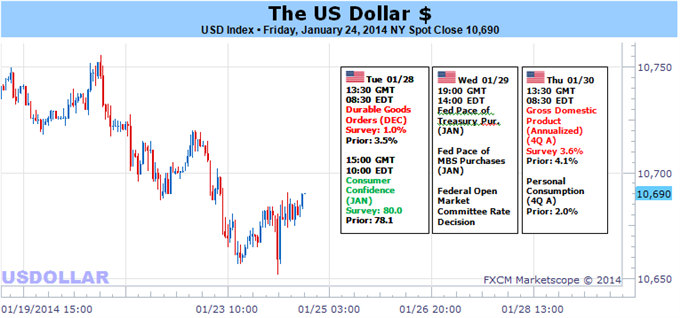
Fundamental Forecast for US Dollar: Bullish
Burgeoning risk aversion could revive the dollar’s safe haven appeal if it persists
Meanwhile, confirmation that the Fed plans to steadily Taper despite capital markets will bolster the greenback’s profile
Trade your opinion on the US Dollar via our Mirror Trader currency basket
The Dow Jones FXCM Dollar Index (ticker = USDollar) recovered its footing through the end of this past week, but the benchmark currency notably suffered through a period defined by severe spasms of risk aversion. Some believe this is a sign that the world’s most prominent reserve currency is losing (or has lost) its role as a traditional safe haven. However, event risk and market activity in the week ahead will likely sort out the benchmark’s fundamental bearings. And, between a second Taper move by the FOMC and possible escalation of fear towards panicked levels; the dollar’s outlook is looking particularly bullish.
While there are many variables and scenarios that can contribute to the dollar’s bearing moving forward, there are two particular themes that will no doubt override the market’s attention: risk appetite and yield expectations (risk and reward as it were). The dollar is in a unique point where its own fundamental course and that of the global scheme happen to support the potential for both the benchmark’s expected returns as well as its virtues through liquidity.
The most pressing question on investors’ minds heading into the weekend was whether the 2.8 percent tumble from the S&P 500 and 46 percent increase in the VIX Volatility Index (often referred to as the ‘fear’ gauge) was the start of something more ominous ahead. The arguments for a meaningful market correction are many and well-known. A market just off of record highs against the backdrop of moderate growth, slowing profit forecasts and historically low yield suffices for our fundamental review here. The real concern, however, is not the analysis but rather the positioning that results from these concerns. The excessive use of leverage (record highs according to the NYSE), the incredible level of complacency (volatility hitting pre-recession lows) and level of participation (open interest in big S&P 500 futures has dropped to 15 year lows) marks a volatile scenario where a healthy unwinding can turn into a disorderly flight to the exit.
This past week, there were a number of news stories that stirred the imagination for fear. The withdrawal of capital from the emerging markets – which led to severe declines in the Argentina Peso and other developing economy currencies – is a symptom of fear. The S&P 500 was relatively slow to respond to this evolving concern as complacency has grown stout over the years. Intraday volume spikes into equity market’s selloff Friday, however, showed the ill-effects of a market that is not prepared for a meaningful pullback. The more persistent the risk retreat, the deeper the vein of fear; and subsequently, the better the dollar looks as a liquidity haven. Unwinding and repatriation of capital is the first major stage. Outright flight to safety is the second.
Whatever the trigger is or will be, it is the backdrop market conditions that will feed any full-scale financial market problems. Not only are the underlying positioning statistics unflattering, but the means for support have been evaporating. While there is plenty of stimulus around the world, the major players have notably capped their support are in the early process of withdrawing it. China’s PBoC has committed to clamping down on credit-spurred growth (with a possible Trust default – China’s first – coming up next week). The ECB has refused a second wave of LTRO-like liquidity despite a rise in short-term rates. Assumed a sure thing, the BoJ has been notably quiet on expectations of an upgrade to its open-ended stimulus program. And, the market believe the BoE will be forced to actually hike rates sometime this year. Then, of course, we have the world’s most prominent and liberal central bank pulling back: the Fed.
In severe risk aversion, the dollar’s ultimate liquidity shines. So, the more severe the fear, the stronger the call for the benchmark currency. However, the Fed’s own monetary policy bearing – a catalyst for risk trends – will also project a steady rise in US-based market returns through the medium-term. Fed officials have made it clear that they intend to proceed with the Taper – some saying even if the market is falling. The dampener on US rates will thereby be lifted even as general sentiment sours. More than likely, other central banks will be forced to pick up the slack as their economic and financial situations are more precarious. The result would be more yield-choking stimulus from the United States’ global counterparts, while the dollar’s safe haven status and future returns view improve. – JK
DailyFX provides forex news and technical analysis on the trends that influence the global currency markets.Learn forex trading with a free practice account and trading charts from FXCM.
Source: Daily fx

